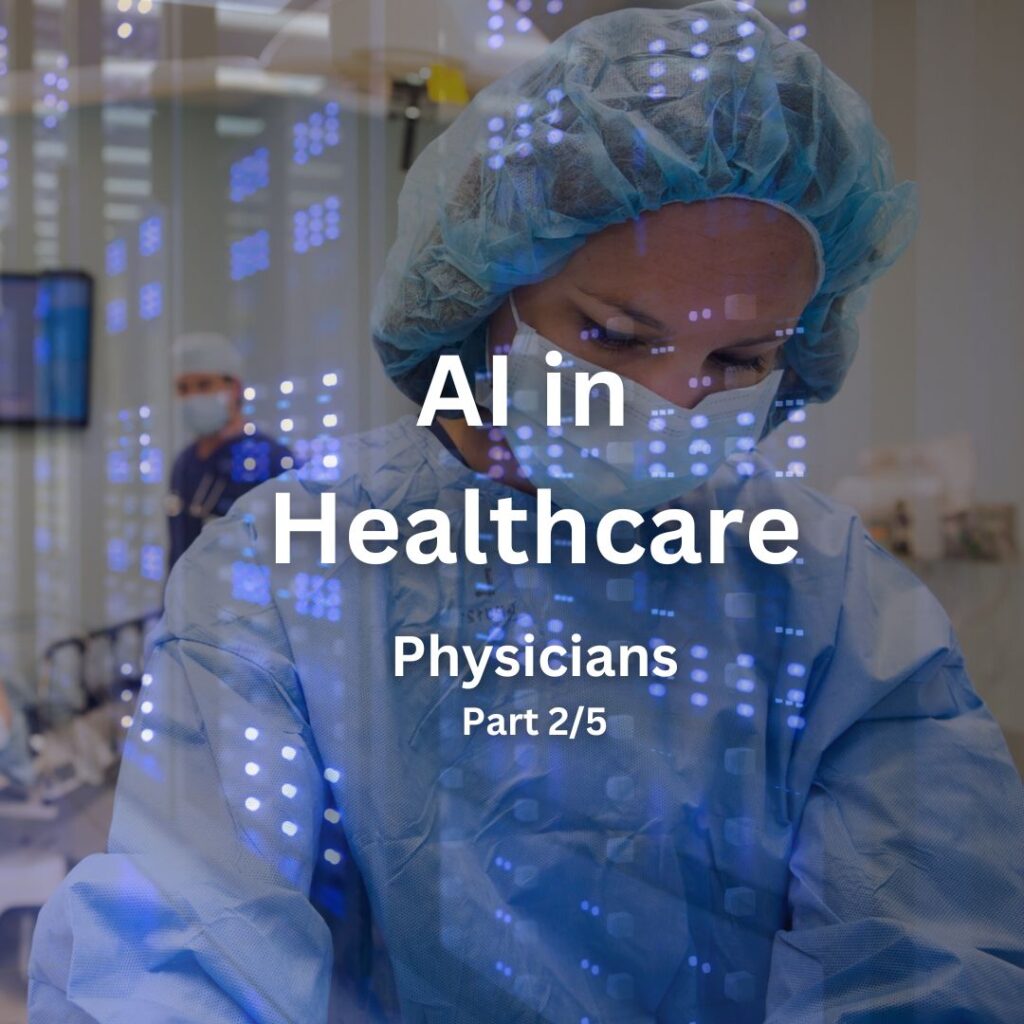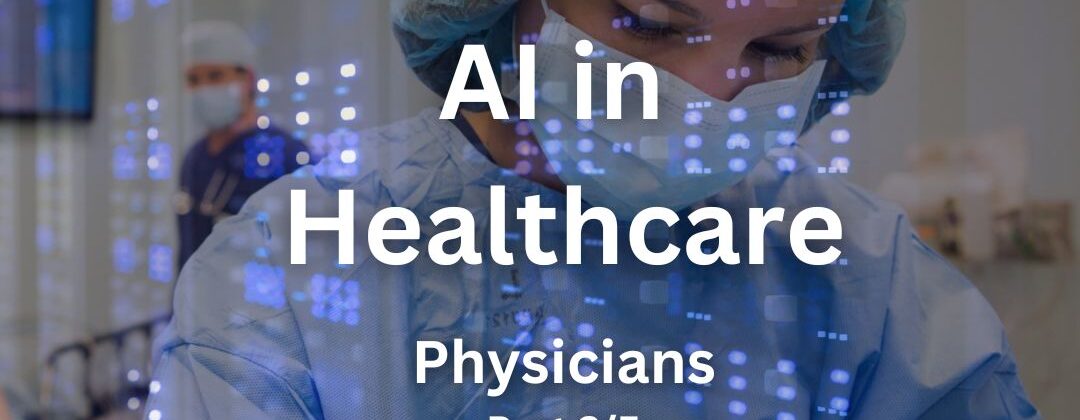
Artificial Intelligence (AI) is new to many, but it has existed for decades. It has hit the news recently, primarily due to the release from OPEN.AI and their ChatGPT platform. (GPT: Generative Pre-Trained Transformers, not the movie kind, and emphasis on the pre-trained part) For the first time, AI is accessible to the masses, and those masses are turning AI into exciting products and offerings, with healthcare being one of the primary recipients.
In the first part of this series, I attempted to set the stage for how pervasive AI has become in the past couple of years. It provided an overview of the impact on healthcare and the areas we’ll look at in this series.
In Part 2, I’ll focus on healthcare delivery by physicians, how they use it to increase their ability to deliver diagnoses and treatments to you, and how they can reduce the burden of all their paperwork. Yes, there’s a lot of paperwork and fax machines!
First a Warning
If only I could make this subheading flash red with a strobe light and a clarion horn! As with any new technology, it will take a while to figure it out. We are a few years into the general release of several AI tools. There will be many missteps, failures, unintended outcomes, lawsuits, and worse.
This is such a concern that many governments are setting up organizations and developing standards to guide companies to help in making safe products and offerings. See the list at the end of this article for some of those regulatory bodies.
I advise you to tread carefully and lightly in this space. Understand the risks and concerns many have as this new technology is released into the world. If even the tech industry building these models is concerned, you should be, too!
Above all, do not share personal information on any chat bot as it is added to the model to help it work better. Once your data is in the model, others can access it. It’s difficult, but it’s there. Only when the company offering the bot/helper tells and shows you that your data is not kept or is kept securely should you even think about entering personal data. You’ve been warned: tread carefully.
The Very Short Version of Healthcare Delivery
When you see a doctor, they have to know who you are and what you’re complaining about, do some real-time diagnosis, offer some recommendations that may or may not include medications or other treatments, and then shake your hand (are they still doing that?) and send you off. That may be going to a specialist or having some tests: taking your blood, having an X-ray, CT, MRI, or something else. All that is supposed to happen in the eight to fifteen minutes you meet with your doctor. Your doctor then spends the rest of their time filling out the paperwork, sometimes hours per day, and faxing records to a specialist. Yes, faxing is still the way a lot of health information is sent between offices.
Typical training for a Medical Doctor (MD) takes about eight to twelve years. They needed to learn anatomy, its functions, and thousands of medications and treatments at that time. Once they pass a test on that knowledge, they start as interns somewhere to gain experience for a year or two. They take more training and practice if they decide to go into a specialty.
By the time most doctors started practicing medicine, healthcare and technologies had changed. Drugs, procedures, and treatments have advanced beyond what they learned in school; it is moving fast. Doctors are continually educating themselves to keep up with the latest in medicine. That’s why you’ll hear them attending conferences or meeting with company reps. They need help to keep up to date; it’s a big challenge. There’s even an app called Human DX that tests their knowledge on various conditions in real-world cases to help with continuing education.
So, if technology can help them reduce time spent on non-medical tasks and spend more time with patients, which is why they got into doctors in the first place, it will be good for everyone. Right?
What Happens in the Doctor’s Office?
The first area to look at is for the doctor to get an overview of the patient. If you’re like me and see your doctor once a year or less, they don’t know you without some help. Here’s where the Electronic Medical Record (EMR) comes into play. The EMR has, or should have, all your medical history so your doctor can scan it to refresh themselves on who you are. Without it, they ask many questions; this part is usually handed off to nurses, who then put that data into the EMR for the doctor to glance at as they talk with you.
Here is where AI is starting to help your doctor. There are several companies developing copilots for doctors. Just like an airplane pilot whose job is to fly the plane, the copilot ensures the aircraft is working and suggests a course of action – a second set of eyes and ears.
Some of these copilots summarize your history, physical information, and past ailments, medications, and treatments. Yes, this has been around on a limited scale without leveraging AI for a while.
How does this work? Most of the major EMR vendors have or are developing AI to look across their data to see not only what is being recommended by other doctors in the health system but also by doctors at large with data that has been cleansed of personally identifiable information. That allows physicians to see what others are doing rather than relying on their own experience, good as it may be. It’s leveraging the vast experience and insight of tens of thousands of doctors to treat your particular ailment. As this longitudinal medical data increases, AI will allow the generation and analyses to model disease progressions, predict future complications, and adjust care plans for your doctor to review and apply.
In addition, many doctors currently have access to a global database of research papers to ask questions. These platforms are actively adding AI capabilities with a conversational approach to get more specific results. Examples are ClinicalKey AI from Elsevier and UpToDate from Wolters Kluwer, two well-respected research publishers. This access generally happens after the visit when there is a question for more information. Google’s Med-PaLM is another LLM built specifically for searchable medical data. Many others are in the market today, and more are coming online shortly. They are all built to provide access to the medical community to make better decisions.
Other AI applications actively listen to the conversation during your appointment and perform the notes to be better searchable by the physician and EMR. It saves a lot of time documenting the visit and the next steps. Doctors should let you know this is being done, and it will eventually be the preferred document method. You should be able to ask for a copy for your records to remind you what happened; this is especially good when caring for someone else. One example is Nuance’s Dragon Ambient eXperience (DAX™) Express.
Specialties
Imaging has become one of the specialties that embraced AI early on. X-ray, CT, and MRI images have had AI assistants for several years. These platforms have shown to be more accurate in picking up additional areas of concern than previously thought.
NanozAI and Viz AI are examples of companies that provide enhanced imaging for radiologists to determine where issues may be in images. Tepus and AIDoc are two companies that leverage AI across multiple specialties: cardiology, neurology, oncology, and radiation, and Visual DX is specific to dermatology.
AI in specialties will only expand as the medical community realizes the vast amounts of data that can or could be used to uncover new treatments and therapies. Don’t be surprised that your doctor has much more information about you and potential ways to heal and cure you when you go in for an appointment next year.
Your Own Health Chatbot
One great opportunity for new AI platforms such as ChatGPT, Bard, Bing, Pi, and many others is to ask them questions and get some pretty good answers, although sometimes generic and confusing. If you spend time learning how to prompt these platforms, they will provide you with more focused responses.
A side note: think of these platforms as if you are speaking to a four-year-old. You’ll have to give them context if you want more than a yes or no response. If you ask them how to get to Grandma’s house, they will tell you “by car.” If you ask them to explain what they see on the way by using colors, shapes, and signs, you get a much more detailed response. This is how these platforms work, and that practice is called prompting the system or prompt engineering.
Several chatbots on the market are already specific to health, from those that just respond using the LLMs provided to others trained in specific medical literature. The better ones will ask you a couple of questions before responding. Those questions are specific prompts they build to provide an answer more suited to your question. Understand that these bots are using whatever that AI’s LLM has been loaded with to answer your questions and that they are not specific to healthcare, so use caution.
More recently, startups have begun building healthcare-specific bots pre-trained on clinical data. Ada, for example, has access to years of medical research documents to answer your medical questions. KHealth takes a similar approach, but their LLM is trained on anonymized patient data to guide a response. These chatbots are even getting specialized, like Aysa, whose focus is on skin conditions.
Summary
Artificial Intelligence will be one of those watershed moments in history. The ability to accelerate learning and provide insight into new areas of medicine will be staggering. Just look at the announcement Google’s Deep Mind group made on November 29th, discovering 2.2MM new types of crystals that could power future technologies, 800 years of research done in a very short time. This same technology is being used in medicine today to find new treatments and protocols in healthcare. It’s hard not to be excited about the direction of these studies and what the future will bring.
Part 3 of this series will look at how AI is used in running a hospital and how the pharmaceutical industry is leveraging it to develop new molecular combinations to test for medicine.
Government regulations/guidelines
EU:
EU AI 1st Regulation on AI
EU Committee on AI
US:
Executive Order on AI
Multi-government agency
Non-government entities focused on AI in Healthcare


Leave a Reply